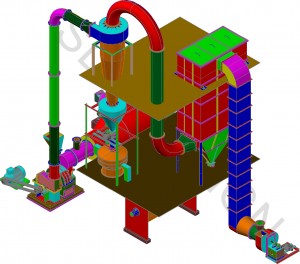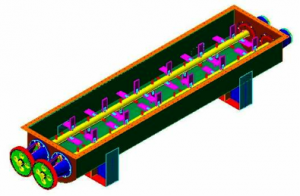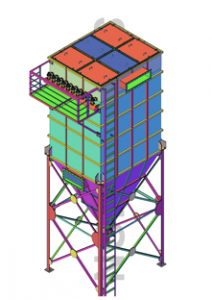
WHY A FLASH DRYER ?
Tunnel and cupboard dryers are inherently costly to run, occupy a larger floor space, involve higher number of manual labor and yet the drying rate is slow with much lower thermal efficiency. Compared to this, the FLASH DRYER in its simplest form of mechanical design; is merely a Hot Air Conveyor into which solids, if reasonable free flowing, may be dropped. The material then gets dispersed, thus exposing maximum surface to the drying process. This leads to a very rapid drying rate and the time required is in seconds and not in minutes or hours. Due to the short exposure time and rapid evaporation of water, even though high temperature is employed; the material remains at wet bulb temperature (W.B.T.) until all traces of surface moisture is removed. Thus it is possible to employ high inlet temperature, may be up to 700 C, without affecting the quality of the material, which may even, if it is a heat sensitive one.
WHY FLASH DRYING, DISINTEGRATION OR PULVERISATION?
In a drying process, the internal moisture in the particle, reaches the surface by capillary action and from here the moisture is removed. In other words, it is obvious that the smaller the particle, more rapid will be the drying process. Thus during the process of grinding or Pulverising if ‘FLASH DRYING’ is also conducted, then it will make the over all system very efficient.
During the normal process of Disintegration or Pulverisation if the material contains high degree of moisture content, then the process of grinding may pose problems due to choking, thereby the output will drop down to a considerable low value. The process will improve satisfactorily if “FLASH DRYING” is also conducted along with grinding. Pick up of the moisture by the feed material may be due to the hygroscopic nature of the material, during transit or storage or may be inherently present in the mining stage.
TYPES OF FLASH DRYERS:
Flash Drying System are designed for specific problems and may fall into one of the following categories:
- Flash Drying without Disintegration or Pulverisation.
- Flash Drying with Disintegration.
- Flash Drying with Pulverisation.
FLASH DRYING WITHOUT DISINTEGRATION OR PULVERISATION:
 If the material to be dried is in a reasonably free flowing form, then flash drying alone without Disintegration or Pulverisation could be employed. Fig.1 illustrates the system consisting of Automatic Feeder, Ventury type gas Conveyors System into the throat of which material is fed, and a Cyclone Separator is installed to separate the dried product. It also requires suitable type of heater.
If the material to be dried is in a reasonably free flowing form, then flash drying alone without Disintegration or Pulverisation could be employed. Fig.1 illustrates the system consisting of Automatic Feeder, Ventury type gas Conveyors System into the throat of which material is fed, and a Cyclone Separator is installed to separate the dried product. It also requires suitable type of heater.
FLASH DRYING CUM DISINTEGRATION:
 The system consisting of Heater, Conditioner and the Disintegrator along with a Cyclone Separator. The Disintegrator is accomplished in a ‘SINGHASINI’ Cage Mill / Hammer Mill. Depending upon a specific requirement a conditioner and or dust collector is included or discluded with the system.The product obtained in the system is not in the form of fine powder.
The system consisting of Heater, Conditioner and the Disintegrator along with a Cyclone Separator. The Disintegrator is accomplished in a ‘SINGHASINI’ Cage Mill / Hammer Mill. Depending upon a specific requirement a conditioner and or dust collector is included or discluded with the system.The product obtained in the system is not in the form of fine powder.
FLASH DRYING CUM PULVERISATION:
High Speed Impact Pulveriser with Cyclone Collector is used into which Hot Air is introduced. This system could easily be adopted with advantage and economy if the end product required is in the form of fine powder. This replaces the system of pre-drying if done in Tunnel, Rotary or Tray Dryers. Similarly as in the case of Flash Drying cum Disintegration a Conditioner and or Dust Collector is included or discluded with the Drying cum Pulverisation system.
TYPICAL LAYOUT ARRANGEMENT OF SDC FLASH DRYING CUM PULVERISING SYSTEM WITH FEED CONDITIONER


FACTOR FOR THE SELECTION OF FLASH DRYING SYSTEMS
A. FEED CONDITIONER:
The Flash Drying system in general is designed to handle damp, crumble and friable materials and not those materials, which are soft and sticky. When materials are from filter press or are having high moisture content (60%-70%), they are soft and sticky. This may thus have very unfavorable drying characteristics. This difficulty could be overcome by making the feed into a friable state by mixing it with a quantity of previously dried material. Due to such treatment, the moisture gets dispersed over several particles. The original area thus makes it possible to dry the material to less than 1% moisture content.
The process of the above treatment is called “CONDITIONING” and is done in a suitable designed Paddle Mixer. This could be done in batches or continuously.The arrangement of such drying system is shown in Fig.2 and Fig.3. It can be seen that a portion of the dry powder leaving the separator is diverted directly into the Conditioner to get mixed with the incoming supply of wet feed.
FEED CONDITIONER
B. CHOICE OF AIR HEATER:
The Flash Dryer could be operated with any convenient source of hot air or gases. If process requirement permits and if available then hot flue gases are conveniently could be used. In cases of other sources of Air Heater, the choice could be made from the following depending upon the availability of the fuel supply, maximum temperature that could be used to get the Hot Air or specific process requirements.
a. STEAM HEATER:
The heater consists of a number of finned tubes inside of which steam is fed. The air is passed over the fin and it gets heated up. The temperature of the hot air depends upon the pressure at which steam is available. This should be at least 100/120 lbs. per sq.inch or higher. The maximum air temperature in such cases would be 170/175 C.
b. DIRECT GAS OIL OR SOLID FEED FIRED HEATER:
The fuel is burnt at a high temperature inside a combustion chamber which is made of special refractory lined bricks. The products of combustion are then diluted with cold air to obtain and control the same at the required working air temperature. Since there is no loss of the flue gases, the overall thermal efficiency in this case is very high. The maximum air temperature in this case could be as high as 700°C.
c. INDIRECT GAS OIL OR SOLID FUEL FIRED HEATERS:
Where the process requirement is such that absolutely pure air is required, we recommend the use of an indirect heater. The heater consists of tube assembly and is located on top of the combustion chambers where the fuel is burnt. The Hot gases of combustion while passing out of the tubes and through the chimney to the atmosphere, heat the air. The air is first filtered, heated by passing it over a series of tubes and discharged by fan to the Flash Dryers.
In cases of solid fuel, firing dampers are provided to isolate the heater and save it from being burnt if the supply of air fails, whereas in case of oil firing, the fuel supply could be cut off as soon as the air blower fails. The highest temperature achieved in this case is limited to about 300°C.
d. ELECTRICAL HEATERS:
The electrical heating system could be of any size and are made of a number of electrical heating elements mounted in a steel casing. This heating system, though neat and convenient, has high operating cost, nearly six times that of the heaters with other fuel sources. The maximum air temperature obtained is limited to 250°C.
C. DUST COLLECTION:
The purge air along with the moisture/vapor may contain small amounts of fine powder, the quantity depending upon the physical properties of the powder, which is under processing. Normally we incorporate a Totally Enclosed Manual Shaking Type of Bag Filter or Reverse Jet Type Pulse Air Bag Filter but other types of system like Wet Scrubbers etc. could be utilized depending upon specific cases.
FACTORS EFFECTING THE CAPACITY AND ITS SELECTION:
We can offer the flash dryers having capacities of 100kg/hr to 5000kg/hr product rate. The capacity of a Flash Dryer or Flash Dryer cum Pulveriser depends upon a specific case. The moisture content of the wet material at which it would become fluffy or friable is the most important factor. It will decide the quantity of dry product to be recycled and fed to the conditioner; with higher moisture content of the wet feed more quantity of the dry product has to be recycled and therefore, the dry material out put would get reduced proportionately. The other factor, which affects the capacity of the dryer, is the maximum allowable temperature of the air. A higher air temperature evaporates more moisture. Hence, depending upon the type of Air Heater chosen, the capacity of the FLASH DRYER CUM PULVERISATION would be affected.
STAR FEATURES:
- Low Power / Fuel Consumption.
- Low Power / Fuel Consumption.
- Automatic Feeder
- Low Operation & Maintenance Cost.
- High Grinding Efficiency.
- Whizzer Classifier.
- High Drying Efficiency.
- Continuous / Uniform Drying.
- High Efficiency Cyclone Separator.
- Reverse Jet Pulse Air Bag Filter.
- Continuous Silica Separator.
- High Reduction Ratio.
- Heavy Duty Construction.
- Forty Years Of Experience
Few Applications of Singhasini Flash Dryer
Moist Minerals & Ores Lindane Washed China Clay
Precipitated Calcium Carbonate Acid Activated Bleaching Earth Activated Calcium Carbonate
Zeolite Pesticides Activated Carbon
Di-Calcium Carbonate Ultramarine Blue Food Products
Benzene Hexa Chloride Different Pigments & Colors De-Oiled Cake


